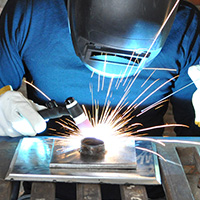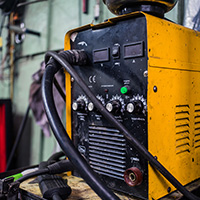TWS is a Great Training Option for Everyone
Learn more about how we can prepare you to advance your career.
If you’re looking for a precision welding process, you might want to consider pulse welding.[1] Not only does the process produce attractive welds, but also it can help with avoiding common welding discontinuities and defects.[2]
Pulse welding is a variation on two core processes commonly taught in a welding training program: gas metal arc welding (MIG) and gas tungsten arc welding (TIG).[3]
Learn more about pulse welding and when to use it with the MIG or TIG processes in this article.
What Is Pulsed Arc Welding?
Electric arc welding processes typically rely on a consistent current or voltage to maintain the arc and heat the metals.[4][5] The welding current is measured in amps and the voltage in volts.[6]
Have You Considered a Career in the Skilled Trades?
Fill out the form to recieve a no obligation info packet.
Pulse welding is different because the current continuously fluctuates from low to high.[7]
Pulse TIG Welding

With pulse TIG welding, the operator would still control the amperage output with a foot pedal, but the amperage output from the TIG torch is a pulsed waveform instead of a steady stream of electrical current. If you were to plot the variations in the electrical current on a graph, the resulting image would be the shape of multiple waves.[8][9]
Pulse MIG Welding

In pulse MIG welding, the current is also varied. The technique was first introduced to improve the control over metal transfer when using currents at low average levels. It relies on directing quick, high-current pulses at the work.[10]
The result is a process in which the filler metal is transferred from the electrode to the weld puddle without contact. The electrode never touches the work. One droplet of molten metal is formed at the end of the electrode per each pulse.
When the current peaks, the droplet is pushed across the arc into the puddle. One droplet is delivered per pulse.[11]
When to Use Pulse Welding
There are several instances where pulse welding can improve the precision and appearance of your welding, as well as help you avoid welding mistakes or defects.
Out-of-Position Welding
When joints are located out of position and difficult to reach, pulse welding can produce cleaner welds. The base metal can congeal to the weld puddle during the trough in current preventing it from dripping out of the joint.[12][13]
Thin Metals
Pulse welding on thin metals reduces the risk of burn through.[14]
Cosmetic Work
Setting the frequency of the pulse to one or lower and manually feeding the welding electrode in tandem can produce visually appealing work.[15]
Metals with High Thermal Conductivity
For projects that weld aluminum or other nonferrous metals, pulsed welding can lower the overall heat generated while working.[16]
Deeper Penetration Welds with Less Heat
When the current cycles to high during pulse welding, the operator can achieve deeper penetration welds. Due to the low cycles, however, the overall heat produced can be lower.[17]
Pulse TIG Welding Advantages
In addition to the above benefits, pulse TIG welding can be helpful under the following circumstances:
- When working in tight spaces
- Cutting down on time by welding at higher pulse speeds
- Improving control and accuracy without filling holes with filler metal when working in difficult positions[18]
Pulse MIG Welding Advantages
Aside from the general advantages of pulse welding, there are some benefits specific to MIG welding:
- Decreased distortion due to lower heat inputs
- Less spatter and need for rework or secondary passes
- Higher deposition rates when welding out of position
- Stronger welds due to better fusion compared to other transfer modes
- Lower level of fumes compared to other modes of transfer.[19]
Building Your Welding Skillset
Under certain circumstances, pulse welding can offer an advantage over straight MIG or TIG welding. These fundamental processes are typically taught in welding school, so students who want to build on these skills can learn the variation of pulse welding. Expanding one’s skillset can often offer a competitive advantage in the job market.[20]
Welding has all kinds of different tools and techniques. Learn what oxy-fuel cutting is all about.
[1] https://www.thefabricator.com/article/arcwelding/a-primer-for-pulsed-welding
[2] https://www.iedepot.ie/blog/pulse-welding/
[3] https://www.millerwelds.com/resources/article-library/considerations-for-switching-to-pulsed-mig-and-pulsed-tig-welding-in-thin-gauge-aluminum-applications
[4] https://www.thefabricator.com/article/arcwelding/arc-welding-101-cv-or-cc-what-s-the-difference-
[5] https://www.bakersgas.com/weldmyworld/2011/03/09/electricity-for-welding/
[6] https://science.howstuffworks.com/environmental/energy/question501.htm
[7] https://www.iedepot.ie/blog/pulse-welding/
[8] https://www.electronics-tutorials.ws/waveforms/waveforms.html
[9] https://jattus.com/what-is-pulse-welding-and-what-do-you-use-it-for/
[10] https://www.twi-global.com/technical-knowledge/faqs/faq-what-is-pulsed-mig-mag-welding-and-what-are-its-advantages-over-conventional-mig-mag-processes
[11] https://www.lincolnelectric.com/en-us/support/process-and-theory/Pages/pulsed-mig-detail.aspx
[12] https://www.thefabricator.com/article/arcwelding/a-primer-for-pulsed-welding
[13] https://www.iedepot.ie/blog/pulse-welding/
[14] https://www.iedepot.ie/blog/pulse-welding/
[15] https://www.iedepot.ie/blog/pulse-welding/
[16] https://www.iedepot.ie/blog/pulse-welding/
[17] https://www.iedepot.ie/blog/pulse-welding/
[18] https://www.bakersgas.com/weldmyworld/2013/11/26/when-to-use-pulse-for-tig-welding/
[19] http://weldinganswers.com/benefits-of-pulse-welding/
[20] http://www.weldingtipsandtricks.com/pulse-tig.html
This blog has been labeled as archived as it may no longer contain the most up-to-date data. For a list of all current blog posts, please visit our blog homepage at https://www.tws.edu/blog/







